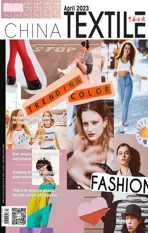Grains add new colors to plant dyeing
2023-07-18EditedbyZhaoXinhua
Edited by Zhao Xinhua

Tinctoria in blue dye, rubia tinctorum and saf—flower in red dye, sophora, turmeric, and gardenia in yellow dye are well—known plant dyes. With the green upgrade of textile and clothing sector, in re—cent years, more plant dyes have been applied in the field of textile dyeing.
In 2022, Riso Gallo, a leading rice producer in Italy, and ALBINI_next led to the development of a dye from a by—product from processing a variety of black rice grown by Riso Gallo. The black rice reaches maturity between September and October.It is then harvested and undergoes a series of pro—cesses and is then sold and consumed. The key moment of the entire process is the hydrothermal treatment dur—ing which the water takes on a deep burgundy colour due to the anthocyanins, the plant pigments covering each single grain of rice. When the boiling has finished, the water is normally discarded. This is where ALBINI_next intervenes, recovering the waste water, transforming it into a natural dye, truly ‘straight off the grain'. To date, the colour palette is composed of four different shades. The dyeing process using Off the Grain distinguishes itself for water savings of between 30% and 40% compared to traditional processes. The formula is used by ALBINI Group to dye certain sustainable textile fibres which it uses to create exclusive fabrics.
ALBINI_next collaborated with GPM Innovation to study the application of indigo derived from vertical farming in an industrial context. This pilot project saw the pigment utilised in traditional batch dyeing process—es, resulting in a yarn dyed with 100% natural indigo.
GPM Innovation specialises in the implementation of integrated cultivation cycles of botanical species with low environmental impact. The company is also focused on the extraction of pigments and dyes from various plant species, including dye plants, for green industrial applications.
The aeroponic technique that GPM Innovation uses does not require the use of soil. Thanks to a support system, it is possible to grow the plantations by feed—ing them directly on the roots with a spray of water and mineral nutrients. Energy—saving LED lights then provide the necessary illumination. The advantages of aeroponic farming over traditional systems include:95% reduction in water consumption; elimination of the use of pesticides and herbicides; reduced land usage;increased productivity; simulation of any weather condi—tion at any time of the year.
TOYOSHIMA, a well—known Japanese textile compa—ny, launched a sustainable development project named"FOOD TEXTILE" in 2016. Through unique technology,about 500 different colors of dyes were extracted from more than 50 kinds of waste fruits and vegetables.
After years of trial and error, Jiangnan Branch of CTA has made a big step forward in plant dyes sector under the guidance of plant dyes intangible cultural heri—tage inheritors. Loose fiber, bobbin yarn, garment dyeing has reached industrial standards. JOMU ARZURE®pure plant dyeing is independently developed by Jiangnan Branch of CTA. It is a pure natural plant dyes without any chemical synthetic organic additives. The productionprocess has obtained the GOTS and the ZDHC. There is also the traditional dyeing process of Tea Dyeing, using different varieties of tea to dye different colors of cloth,the color fastness of the product reaches above 4 level,mite repellent rate reaches 65.61%.

Plant dyes gives fashion a natural color. “Natural dyes are like oil paints; they are rich and have so much depth,” says Araks Yeramyan, founder of luxury lingerie and swimwear brand Araks (it offers a capsule collection of plant—dyed linen sleepwear). “The choices are limited,but when you get the color you love, it is magic. Some—times, I feel like the colors are shining.”
杂志排行
China Textile的其它文章
- Is it possible to get fruits and dresses from a plant?
- The revolution of tape: stick it anywhere you want!
- How does bio-based leather become the favorite of luxury brands?
- Brief analysis on the application of nanocellulose in textile field
- What fabrics are popular with students in China?
- Survey: Results of the 18th ITMF Global Textile Industry
